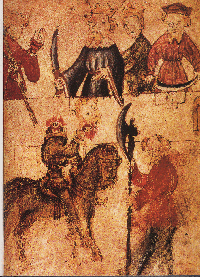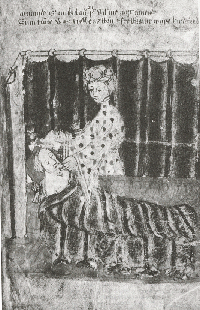

Explorations in Arthurian Legends
A Literature Review
Part 5: Sir Gawain and the Green Knight
The poem has 2,500 alliterative lines that are broken up into irregular stanzas by short rhyming passages.
The story is basically this: Gawain and other knights are in attendance at Arthur's court on New Year's Day. Arthur, as is his custom, refuses to eat until he has seen some marvel. A mysterious man appears and issues a challenge: One man may strike him one blow with an axe. If he survives, he will expect the knight who struck the blow to afford him the same chance in a year's time. Gawain takes up the challenge and beheads the man. The man grabs his head, laughs, and tells Gawain to fulfill his part of the bargain. The Green Knight leaves the axe as a memento and a sharp reminder of Gawain's promise: He must go to the Green Chapel in a year and a receive a blow just like the one he gave the Green Knight. Not to be thought cowardly or vulnerable, Gawain agrees.
ннннн Fast forward to the following December:
Gawain returns to Arthur's court, the knights
rejoice to see him alive, and they all wear green girdles in his
honor.
This poem is largely regarded as the finest of its
kind. Preserved in the same manuscript with the Green Knight tale
were three other poems: Patience, Purity, and Pearl.
The author of these four tales is frequently referred to as the
"Pearl Poet."
We have seen the restrained love and earthly deeds
of knights in early English works, followed by the flowering of
romance in French and German works; we have seen one of Arthur's
greatest knights, Gawain, have one of Camelot's greatest adventures.
The path is made clear for Sir
Thomas Malory.
нн
ннннн
нннннннн
ннннн  ннннн
ннннн Gawain is best known for his adventure with the Green Knight. In this famous tale, Gawain is a devout but humanly imperfect Christian who wins a test of arms, resists temptation by a lord's wife, but succumbs to an offer of invulnerability.
нн
нн
ннннн
ннннн
нннннннн
нн  ннннн
ннннн
|
нннннннн
A Character Analysis of Gawain |
нн
Back to

Explorations in Arthurian History and Legends
Main
Page
Other
нн
ннннн
нн
нннннннн
ннннн
нннннннн
нн
ннннн
нн
нннннннн
нн ннн
нннннннн
нн
ннннн
нн
нннннннн
ннннн
нннннннн
нн
ннннн
нн
нннннннн
ннннн
нннннннн
нн
ннннн
нн
нннннннн
ннннн
нннннннн
нн
ннннн
нн
нннннннн
ннннн
нннннннн
нн
ннннн
нн
нннннннн
ннннн
нннннннн
нн
ннннн
нннннннн
ннннн
нннннннн
нн
нн
ннннн
нн
нннннннн
ннннн
нннннннн
нн
ннннн
нннннннн
ннннн
нннннннн
нн
© 2000-2009 David White